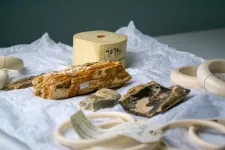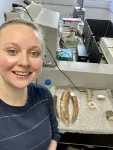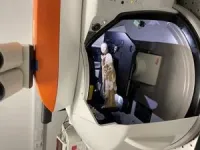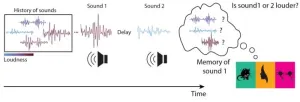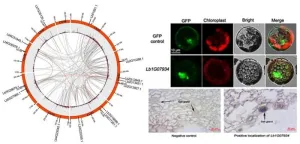(Press-News.org) A new way of quickly distinguishing between illegal elephant ivory and legal mammoth tusk ivory could prove critical to fighting the illegal ivory trade. A laser-based approach developed by scientists at the Universities of Bristol and Lancaster, could be used by customs worldwide to aid in the enforcement of illegal ivory from being traded under the guise of legal ivory. Results from the study are published in PLOS ONE today [24 April].
Despite the Convention on the International Trade in Endangered Species (CITES) ban on ivory, poaching associated with its illegal trade has not prevented the suffering of elephants and is estimated to cause an eight per cent loss in the world's elephant population every year. The 2016 African Elephant Database survey estimated a total of 410,000 elephants remaining in Africa, a decrease of approximately 90,000 elephants from the previous 2013 report.
While trading/procuring elephant ivory is illegal, it is not illegal to sell ivory from extinct species, such as preserved mammoth tusk ivory. This legal source of ivory is now part of an increasing and lucrative ‘mammoth hunter’ industry. It also poses a time-consuming and enforcement problem for customs teams, as ivory from these two different types of tusk are broadly similar making it difficult to distinguish from one another, especially once specimens have become worked or carved.
In this new study, scientists from Bristol’s School of Anatomy and Lancaster Medical School sought to establish whether Raman spectroscopy, which is already used in the study of bone and mineral chemistry, could be modified to accurately detect differences in the chemistry of mammoth and elephant ivory. The non-destructive technology, which involves shining a high-energy light at an ivory specimen, can detect small biochemical differences in the tusks from elephants and mammoths.
Researchers scanned samples of mammoth and elephant tusks from London’s Natural History Museum using the laser based method, Raman spectroscopy. Results from the experiment found the technology provided accurate, quick and non-destructive species identification.
Dr Rebecca Shepherd, formerly of Lancaster Medical School and now at the University of Bristol’s School of Anatomy, explained “The gold standard method of identification recommended by The United Nations Office on Drugs and Crime for assessing the legality of ivory predominantly are expensive, destructive and time-consuming techniques.
“Raman spectroscopy can provide results quickly (a single scan takes only a few minutes), and is easier to use than current methods, making it easier to determine between illegal elephant ivory and legal mammoth tusk ivory. Increased surveillance and monitoring of samples passing through customs worldwide using Raman spectroscopy could act as a deterrent to those poaching endangered and critically endangered species of elephant.”
Dr Jemma Kerns of Lancaster Medical School, added: “The combined approach of a non-destructive laser-based method of Raman spectroscopy with advanced data analysis holds a lot of promise for the identification of unknown samples of ivory, which is especially important, given the increase in available mammoth tusks and the need for timely identification.”
Alice Roberts, Professor of Public Engagement in Science, from the University of Birmingham and one of the study’s co-authors, said: “There’s a real problem when it comes to stamping down on the illegal trade in elephant ivory. Because trading in ancient mammoth ivory is legal. The compete tusks of elephants and mammoths look very different, but if the ivory is cut into small pieces, it can be practically impossible to tell apart elephant ivory from well-preserved mammoth ivory. I was really pleased to be part of this project exploring a new technique for telling apart elephant and mammoth ivory. This is great science, and should help the enforcers - giving them a valuable and relatively inexpensive tool to help them spot illegal ivory."
Professor Adrian Lister, one of the study’s co-authors from the Natural History Museum, added: “Stopping the trade in elephant ivory has been compromised by illegal ivory objects being described or disguised as mammoth ivory (for which trade is legal). A quick and reliable method for distinguishing the two has long been a goal, as other methods (such as radiocarbon dating and DNA analysis) are time-consuming and expensive. The demonstration that the two can be separated by Raman spectroscopy is therefore a significant step forward; also, this method (unlike the others) does not require any sampling, leaving the ivory object intact.”
Professor Charlotte Deane, Executive Chair of EPSRC, said: “By offering a quick and simple alternative to current methods, the use of Raman spectroscopy could play an important role in tackling the illegal ivory trade.
“The researchers’ work illustrates how the development and adoption of innovative new techniques can help us to address problems of global significance.”
The study was funded by the Engineering and Physical Sciences Research Council (EPSRC) and involved researchers from the Universities of Lancaster and Birmingham and the Natural History Museum.
END
Laser technology offers breakthrough in detecting illegal ivory
New approach critical to fighting illegal trade
2024-04-24
ELSE PRESS RELEASES FROM THIS DATE:
Why can’t robots outrun animals?
2024-04-24
Robotics engineers have worked for decades and invested many millions of research dollars in attempts to create a robot that can walk or run as well as an animal. And yet, it remains the case that many animals are capable of feats that would be impossible for robots that exist today.
“A wildebeest can migrate for thousands of kilometres over rough terrain, a mountain goat can climb up a literal cliff, finding footholds that don't even seem to be there, and cockroaches can lose a leg and not slow down,” ...
After spinal cord injury, neurons wreak havoc on metabolism
2024-04-24
COLUMBUS, Ohio – Conditions such as diabetes, heart attack and vascular diseases commonly diagnosed in people with spinal cord injuries can be traced to abnormal post-injury neuronal activity that causes abdominal fat tissue compounds to leak and pool in the liver and other organs, a new animal study has found.
After discovering the connection between dysregulated neuron function and the breakdown of triglycerides in fat tissue in mice, researchers found that a short course of the drug gabapentin, commonly prescribed for nerve pain, prevented ...
Network model unifies recency and central tendency biases
2024-04-24
Neuroscientists have revealed that recency bias in working memory naturally leads to central tendency bias, the phenomenon where people’s (and animals’) judgements are biased towards the average of previous observations. Their findings may hint at why the phenomenon is so ubiquitous.
Researchers in the Akrami Lab at the Sainsbury Wellcome Centre at UCL and the Clopath Lab at Imperial College London developed a network model with a working memory module and another accounting for sensory histories. The study, published in eLife, describes how the model shows neural circuits ...
Ludwig Lausanne scientists identify and show how to target a key tumor defense against immune attack
2024-04-24
April 24, 2024, NEW YORK – A Ludwig Cancer Research study has discovered how a lipid molecule found at high levels within tumors undermines the anti-cancer immune response and compromises a recently approved immunotherapy known as adoptive cell therapy (ACT) using tumor infiltrating lymphocytes, or TIL-ACT. In this individualized cell therapy, TILs—CD8+ T cells that kill cancer cells—are expanded in culture from a patient’s tumor samples and reinfused into the patient as a treatment.
Researchers led by Ludwig Lausanne’s Matteo ...
Can climate change accelerate transmission of malaria? Pioneering research sheds light on impacts of temperature
2024-04-24
In 2022, an estimated 249 million malaria cases killed 608,000 people in 85 countries worldwide including the United States, according to the World Health Organization.
Malaria continues to pose a considerable public health risk in tropical and subtropical areas, where it impacts human health and economic progress.
Despite concerns about the potential impact of climate change on increasing malaria risk, there is still limited understanding of how temperature affects malaria transmission – until now.
Malaria is a mosquito-borne disease caused by a parasite that spreads from bites of infected female Anopheles mosquitoes. If left untreated in humans, malaria can cause severe symptoms, ...
A new attempt to identify salt gland development and salt resistance genes of Limonium bicolor ——Identification of bHLH gene family and its function analysis in salt gland development
2024-04-24
The secondary salinization of saline-alkali land is increasing globally. It is of strategic significance to explore the salt-tolerant molecular mechanism of halophytes and cultivate saline-alkali resistant crops for the improvement of saline-alkali land. The recretohalophyte Limonium bicolor has a unique salt-secreting structure, salt gland, which can directly excrete Na+ out of the body to effectively avoid salt stress. Exploring the development mechanism of salt gland structure in recretohalophyte is of great significance for analyzing the development of plant epidermis structure and improving the salt-resistant mechanism of plants.
Recently, Wang ...
The SAPIENS Podcast named finalist at the 16th Annual Shorty Awards
2024-04-24
SAPIENS: A Podcast for Everything Human has been named as a 16th Annual Shorty Awards finalist in the Science and Technology Podcast Category.
The Shorty Awards honor the best work in digital and social media by the most creative and influential brands, agencies, organizations, and individuals whose work has excelled in creativity, strategy, and effectiveness.
SAPIENS’s work has demonstrated outstanding performance across the judging criteria, which makes it a top contender for a Shorty Award in a most competitive year. The work is also eligible for ...
Startup financing gender gaps greater in societies where women are more empowered
2024-04-24
Commercial bankers provide capital to fund the operations and growth of businesses. However, as these lenders evaluate entrepreneurs who apply for loans, gender bias leads to women being denied more often than their male counterparts.
Estimates show a $1.7 trillion financing gap worldwide for small- and medium-sized enterprises owned by women.
Studies show that when women do secure business loans, the amounts tend to be smaller, have higher interest rates and require more collateral, which restricts the economic potential of women-led ventures. However, findings ...
Postpartum depression after adolescent stress shows a dysregulated HPA axis: a cross-species translational study
2024-04-24
BIRMINGHAM, Ala. – Adverse life events are a known and predominant risk factor for postpartum depression in women after delivery of their baby. Furthermore, the postpartum depression in women who have experienced adverse life events tends to be refractory to treatment.
In a study using a mouse model and human subjects, researchers from the University of Alabama at Birmingham and Johns Hopkins Medicine show that stress from adolescent social isolation in mice elicits a prolonged elevation of corticosterone levels and glucocorticoid signaling, which in turn results ...
When studies conflict: building a decision-support system for clinicians
2024-04-24
One day you hear that red wine is good for your heart. The next day, it’s not. The same goes for chocolate. And coffee. The see-saw of contradicting information isn’t anything new, but what happens when clinicians hear conflicting studies about a medication they use for their patients? Researchers at the Perelman School of Medicine at the University of Pennsylvania are hoping to use, among other methods, a variety of artificial intelligence to help sort that out.
Ellen Caniglia, ScD, an assistant professor of Epidemiology and Enrique Schisterman, PhD, a professor and the chair of the Department of Biostatistics, Epidemiology, and Informatics (DBEI), ...
LAST 30 PRESS RELEASES:
Theory-breaking extremely fast-growing black hole
ŌURA and National University of Singapore open Joint Lab to advance research in personalized preventive health
Hope for smarter lung cancer care
Singapore scientists discover lung cancer's "bodyguard system" - and how to disarm it
Bacteria use wrapping flagella to tunnel through microscopic passages
New critique prompts correction of high-profile Yellowstone aspen study, highlighting challenges in measuring ecosystem response to wolf reintroduction
Stroke survivors miss critical treatment, face greater disability due to systemic transfer delays
Delayed stroke care linked to increased disability risk
Long term use of anti-acid drugs may not increase stomach cancer risk
Non-monetary 'honor-based' incentives linked to increased blood donations
Natural ovulation as effective as hormones before IVF embryo transfer
Major clinical trial provides definitive evidence of impacts of steroid treatment on severe brain infection
Low vitamin D levels shown to raise risk of hospitalization with potentially fatal respiratory tract infections by 33%
Diagnoses of major conditions failing to recover since the pandemic
Scientists solve 66 million-year-old mystery of how Earth’s greenhouse age ended
Red light therapy shows promise for protecting football players’ brains
Trees — not grass and other greenery — associated with lower heart disease risk in cities
Chemical Insights scientist receives Achievement Award from the Society of Toxicology
Breakthrough organic crystalline material repairs itself in extreme cold temperatures, unlocking new possibilities for space and deep-sea technologies
Scientists discover novel immune ‘traffic controller’ hijacked by virus
When tropical oceans were oxygen oases
Positive interactions dominate among marine microbes, six-year study reveals
Safeguarding the Winter Olympics-Paralympics against climate change
Most would recommend RSV immunizations for older and pregnant people
Donated blood has a shelf life. A new test tracks how it's aging
Stroke during pregnancy, postpartum associated with more illness, job status later
American Meteorological Society announces new executive director
People with “binge-watching addiction” are more likely to be lonely
Wild potato follows a path to domestication in the American Southwest
General climate advocacy ad campaign received more public engagement compared to more-tailored ad campaign promoting sustainable fashion
[Press-News.org] Laser technology offers breakthrough in detecting illegal ivoryNew approach critical to fighting illegal trade
